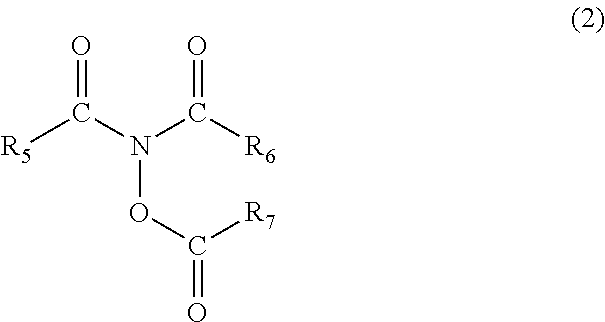Nonaqueous secondary battery and flame retardant for use in the same
a secondary battery and flame retardant technology, applied in the field flame retardants for use in batteries, can solve the problems of nonaqueous secondary batteries that may suffer from leakage of nonaqueous electrolyte solutions, fire or burning, vaporization and/or decomposition of organic solvents
- Summary
- Abstract
- Description
- Claims
- Application Information
AI Technical Summary
Benefits of technology
Problems solved by technology
Method used
Image
Examples
example 1
[0084]To 79.5 g of a mixed solvent of ethylene carbonate and diethyl carbonate (mixing ratio (volume ratio): ethylene carbonate / diethyl carbonate=1 / 2) (aprotic organic solvent), 20.0 g of a cyclic nitrogen-containing compound represented by the following formula (1-1) (a six-membered ring compound represented by the general formula (1b), wherein R1 to R4 represent methyl groups, X represents a hydrocarbon group having 2 carbon atoms (ethylene group), (a flame retardant for nonaqueous secondary batteries, 3,3,6,6-tetramethyl-3,4,5,6-tetrahydropyridazine, decomposition temperature: 146° C.)
and 0.5 g of an amine derivative represented by the following formula (2-1) (N,N,O-triacetylhydroxylamine represented by the general formula (2), wherein R5 to R7 are methyl groups (product by Tokyo Chemical Industry Co., Ltd.) (amine derivative A) were added.
[0085]In the mixed solvent obtained, LiPF6 as a lithium salt was dissolved at a concentration of 1.0 mol / kg to prepare a nonaqueous electrolyt...
example 2
[0089]A nonaqueous secondary battery was produced in the same manner as in Example 1 except that the amount of the mixed solvent of ethylene carbonate and diethyl carbonate was changed to 98.5 g, the amount of the cyclic nitrogen-containing compound was changed to 1 g, and the amount of the amine derivative A was changed to 0.5 g.
example 3
[0090]A nonaqueous secondary battery was produced in the same manner as in Example 1 except that the amount of the mixed solvent of ethylene carbonate and diethyl carbonate was changed to 39.5 g, the amount of the cyclic nitrogen-containing compound was changed to 60 g, and the amount of the amine derivative A was changed to 0.5 g.
PUM
 Login to View More
Login to View More Abstract
Description
Claims
Application Information
 Login to View More
Login to View More - R&D
- Intellectual Property
- Life Sciences
- Materials
- Tech Scout
- Unparalleled Data Quality
- Higher Quality Content
- 60% Fewer Hallucinations
Browse by: Latest US Patents, China's latest patents, Technical Efficacy Thesaurus, Application Domain, Technology Topic, Popular Technical Reports.
© 2025 PatSnap. All rights reserved.Legal|Privacy policy|Modern Slavery Act Transparency Statement|Sitemap|About US| Contact US: help@patsnap.com



